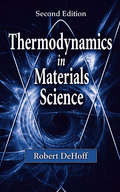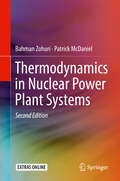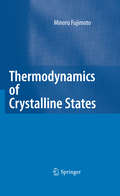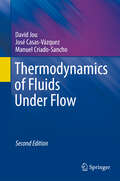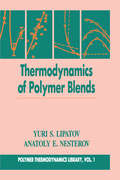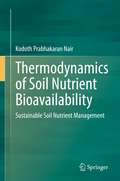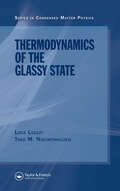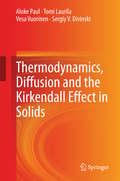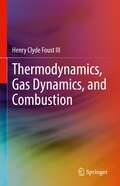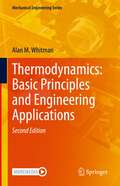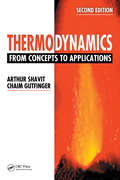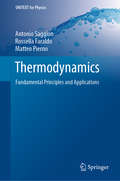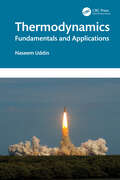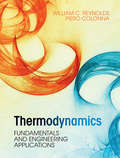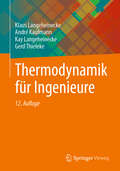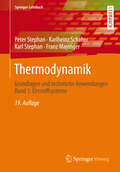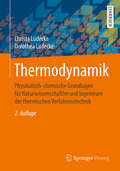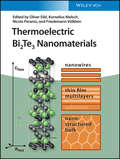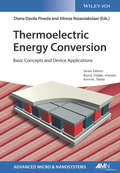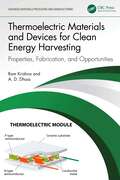- Table View
- List View
Thermodynamics for the Practicing Engineer
by Louis Theodore Francesco Ricci Timothy Van VlietThis book concentrates specifically on the applications of thermodynamics, rather than the theory. It addresses both technical and pragmatic problems in the field, and covers such topics as enthalpy effects, equilibrium thermodynamics, non-ideal thermodynamics and energy conversion applications. Providing the reader with a working knowledge of the principles of thermodynamics, as well as experience in their application, it stands alone as an easy-to-follow self-teaching aid to practical applications and contains worked examples.
Thermodynamics in Materials Science
by Robert DeHoffThermodynamics in Materials Science, Second Edition is a clear presentation of how thermodynamic data is used to predict the behavior of a wide range of materials, a crucial component in the decision-making process for many materials science and engineering applications. This primary textbook accentuates the integration of principles, strategies, a
Thermodynamics in Nuclear Power Plant Systems
by Bahman Zohuri Patrick McDanielThis revised book covers the fundamentals of thermodynamics required to understand electrical power generation systems, honing in on the application of these principles to nuclear reactor power systems. This text treats the fundamentals of thermodynamics from the perspective of nuclear power systems. In addition to the Four Laws of Thermodynamics, it discusses Brayton and Rankine power cycles in detail with an emphasis on how they are implemented in nuclear systems. Chapters have been brought up-to-date due to significant new results that have become available for intercooled systems and combined cycles and include an updated steam table. The book starts with basic principles of thermodynamics as applied to power plant systems. It then describes how Nuclear Air-Brayton systems will work. It documents how they can be designed and the expected ultimate performance. It describes several types of Nuclear Air-Brayton systems that can be employed to meet different requirements and estimates component sizes and performance criteria for Small Modular Reactors (SMR) based on the Air-Brayton concept. The book provides useful insight into the engineering of nuclear power systems for students and the tabular data will be of great use to practicing engineers.
Thermodynamics of Crystalline Materials: From Nano to Macro (SpringerBriefs in Materials)
by Jean-Claude TedenacThis book provides expert treatment of the use of the Calphad calculations for the study of crystal structures and thermodynamics relationships in phase diagram determination. After a short review of the relationships between crystal structures and the thermodynamics of materials, including all possible phase transformations, the book proceeds to a brief discussion of the methods for solving the stability hierarchy of different phases. Coverage includes both theoretical calculations and experimental methods based on classical thermodynamics, with emphasis on the latter. The experimental approach is mainly carried out using heat-exchange data associated with the transition of one form into another. It is demonstrated that the crystallographic properties must be associated with the phase transformations and should be taken into account. The role of X-ray crystallography therein is also discussed. Readers interested in carrying out related research will appreciate the detailed discussion and critical analysis of key results obtained by the author and his colleagues over the past five years.
Thermodynamics of Crystalline States
by Minoru FujimotoThermodynamics is an established discipline of physics for properties of matter in thermal equilibrium surroundings. Applying to crystals, however, the laws encounter undefined properties of crystal lattices, which therefore need to be determined for a legitimate description of crystalline states. Intended for readers with prior knowledge of condensed matter physics, this book emphasizes the roles played by order variables and dynamic lattices in crystals for thermodynamics of crystalline states. The crystalline state is generally heterogeneous, where order variables are in collective motion interacting with the lattice at excited levels, as witnessed in transition anomalies in dielectric crystals and from superconducting transitions in metals. The collective motion exhibits finite amplitude due to long-range order, breaking lattice symmetry that leads to a structural change. Such a non-linear process is discussed in the chapter of soliton theory, and related experimental evidences are also listed in this book. This book is divided into three parts for the convenience of readers. In Part I, basic concepts of phonons and order variables are reviewed. Part 2 is devoted to discussions of binary transitions, and in Part 3 we discuss superconducting transitions in simple metals.
Thermodynamics of Crystalline States, 2nd Edition
by Minoru FujimotoThermodynamics is a well-established discipline of physics for properties of matter in thermal equilibrium with the surroundings. Applying to crystals, however, the laws encounter undefined properties of crystal lattice, which therefore need to be determined for a clear and well-defined description of crystalline states. Thermodynamics of Crystalline States explores the roles played by order variables and dynamic lattices in crystals in a wholly new way. The book begins by clarifying basic concepts for stable crystals. Next, binary phase transitions are discussed to study collective motion of order variables, as described mostly as classical phenomena. New to this edition is the examination of magnetic crystals, where magnetic symmetry is essential for magnetic phase transitions. The multi-electron system is also discussed theoretically, as a quantum-mechanical example, for superconductivity in metallic crystals. Throughout the book, the role played by the lattice is emphasized and studied in-depth. Thermodynamics of Crystalline States is an introductory treatise and textbook on mesoscopic phenomena in solid states, constituting a basic subject in condensed matter physics. While this book serves as a guide for advanced students in physics and material science, it can also be useful as a reference for all professionals in related fields. Minoru Fujimoto is author of Physics of Classical Electromagnetism (Springer, 2007) and The Physics of Structural Phase Transitions (Springer, 2005).
Thermodynamics of Fluids Under Flow
by David Jou José Casas-Vázquez Manuel Criado-SanchoThis is the second edition of the book "Thermodynamics of Fluids under Flow," which was published in 2000 and has now been corrected, expanded and updated. This is a companion book to our other title Extended irreversible thermodynamics (D. Jou, J. Casas-Vázquez and G. Lebon, Springer, 4th edition 2010), and of the textbook Understanding non-equilibrium thermodynamics (G. Lebon, D. Jou and J. Casas-Vázquez, Springer, 2008. The present book is more specialized than its counterpart, as it focuses its attention on the non-equilibrium thermodynamics of flowing fluids, incorporating non-trivial thermodynamic contributions of the flow, going beyond local equilibrium theories, i.e., including the effects of internal variables and of external forcing due to the flow. Whereas the book's first edition was much more focused on polymer solutions, with brief glimpses into ideal and real gases, the present edition covers a much wider variety of systems, such as: diluted and concentrated polymer solutions, polymer blends, laminar and turbulent superfluids, phonon hydrodynamics and heat transport in nanosystems, nuclear collisions, far-from-equilibrium ideal gases, and molecular solutions. It also deals with a variety of situations, emphasizing the non-equilibrium flow contribution: temperature and entropy in flowing ideal gases, shear-induced effects on phase transitions in real gases and on polymer solutions, stress-induced migration and its application to flow chromatography, Taylor dispersion, anomalous diffusion in flowing systems, the influence of the flow on chemical reactions, and polymer degradation. The new edition is not only broader in scope, but more educational in character, and with more emphasis on applications, in keeping with our times. It provides many examples of how a deeper theoretical understanding may bring new and more efficient applications, forging links between theoretical progress and practical aims. This updated version expands on the trusted content of its predecessor, making it more interesting and useful for a larger audience.
Thermodynamics of Polymer Blends, Volume I
by Anatoly E. Nesterov Yuri S. LipatovThermodynamics is an indispensable tool for developing a large and growing fraction of new polymers and polymer blends. These two volumes show the researcher how thermodynamics can be used to rank polymer pairs in order of immiscibility, including the search for suitable chemical structure of compatibilizers. Because of the great current commercial interest in this most dynamic sector of the polymer industry, there is high interest in studying their physical and mechanical properties, their structures, and the processes of their formation and manufacture. These Books are dedicated to Analysis of the Thermodynamics of Polymer Blends. Thermodynamic behavior of blends determines the compatibility of the components, their morphological features, rheological behavior, and microphase structures. As a result, the most important physical and mechanical characteristics of blends can be identified. The information in these two volumes will be useful to all those involved in polymer research, development, analysis and advanced process engineering.
Thermodynamics of Soil Nutrient Bioavailability: Sustainable Soil Nutrient Management
by Kodoth Prabhakaran NairThis book focusses on the thermodynamics of soil nutrient bioavailability, and in particular the most important plant nutrients such as, phosphorus and potassium, among major nutrients, and zinc among micronutrients. It proposes a paradigm shift in the approach to global soil testing procedures. Historically, soil testing has been used to quantify availability of essential plant nutrients to field-grown crops. However, contemporary soil tests are based on philosophies and procedures developed several decades ago, without significant changes in their general approach. For a soil test to be accurate, one needs to clearly understand the physico-chemico-physiological processes at the soil-root interface and, an understanding of soils and plant root systems as polycationic systems is essential. It is this knowledge that leads to sound prescriptive soil nutrient management inasmuch as soil nutrient bioavailability vis-à-vis fertilizer application is concerned, because, of all the factors which govern sustainability in crop production, the nutrient factor is the most important, yet, it is also least resilient to management. This book provides a clear scientific basis of the thermodynamics of soil nutrient bio availability, which routine soil testing does not provide
Thermodynamics of the Glassy State
by Luca Leuzzi Th. M NieuwenhuizenIn the past thirty years, the area of spin glasses has experienced rapid growth, including the development of solvable models for glassy systems. Yet these developments have only been recorded in the original research papers, rather than in a single source. Thermodynamics of the Glassy State presents a comprehensive account of the modern theory of
Thermodynamics with Chemical Engineering Applications
by Elias I. FransesMaster the principles of thermodynamics with this comprehensive undergraduate textbook, carefully developed to provide students of chemical engineering and chemistry with a deep and intuitive understanding of the practical applications of these fundamental ideas and principles. Logical and lucid explanations introduce core thermodynamic concepts in the context of their measurement and experimental origin, giving students a thorough understanding of how theoretical concepts apply to practical situations. A broad range of real-world applications relate key topics to contemporary issues, such as energy efficiency, environmental engineering and climate change, and further reinforce students' understanding of the core material. This is a carefully organized, highly pedagogical treatment, including over 500 open-ended study questions for discussion, over 150 varied homework problems, clear and objective standards for measuring student progress, and a password-protected solution manual for instructors.
Thermodynamics, Diffusion and the Kirkendall Effect in Solids
by Tomi Laurila Vesa Vuorinen Aloke Paul Sergiy V. DivinskiIn this book basic and some more advanced thermodynamics and phase as well as stability diagrams relevant for diffusion studies are introduced. Following, Fick's laws of diffusion, atomic mechanisms, interdiffusion, intrinsic diffusion, tracer diffusion and the Kirkendall effect are discussed. Short circuit diffusion is explained in detail with an emphasis on grain boundary diffusion Recent advances in the area of interdiffusion will be introduced. Interdiffusion in multi-component systems is also explained. Many practical examples will be given, such that researches working in this area can learn the practical evaluation of various diffusion parameters from experimental results. Large number of illustrations and experimental results are used to explain the subject. This book will be appealing for students, academicians, engineers and researchers in academic institutions, industry research and development laboratories.
Thermodynamics, Gas Dynamics, and Combustion
by Henry Clyde Foust IIIThis textbook provides students studying thermodynamics for the first time with an accessible and readable primer on the subject. The book is written in three parts: Part I covers the fundamentals of thermodynamics, Part II is on gas dynamics, and Part III focuses on combustion. Chapters are written clearly and concisely and include examples and problems to support the concepts outlined in the text. The book begins with a discussion of the fundamentals of thermodynamics and includes a thorough analysis of engineering devices. The book moves on to address applications in gas dynamics and combustion to include advanced topics such as two-phase critical flow and blast theory. Written for use in Introduction to Thermodynamics, Advanced Thermodynamics, and Introduction to Combustion courses, this book uniquely covers thermodynamics, gas dynamics, and combustion in a clear and concise manner, showing the integral connections at an advanced undergraduate or graduate student level.
Thermodynamics: Basic Principles and Engineering Applications (Mechanical Engineering Series)
by Alan M. WhitmanThis textbook is for a one semester introductory course in thermodynamics, primarily for use in a mechanical or aerospace engineering program, although it could also be used in an engineering science curriculum. The book contains a section on the geometry of curves and surfaces, in order to review those parts of calculus that are needed in thermodynamics for interpolation and in discussing thermodynamic equations of state of simple substances. It presents the First Law of Thermodynamics as an equation for the time rate of change of system energy, the same way that Newton’s Law of Motion, an equation for the time rate of change of system momentum, is presented in Dynamics. Moreover, this emphasis illustrates the importance of the equation to the study of heat transfer and fluid mechanics. New thermodynamic properties, such as internal energy and entropy, are introduced with a motivating discussion rather than by abstract postulation, and connection is made with kinetic theory. Thermodynamic properties of the vaporizable liquids needed for the solution of practical thermodynamic problems (e.g. water and various refrigerants) are presented in a unique tabular format that is both simple to understand and easy to use. All theoretical discussions throughout the book are accompanied by worked examples illustrating their use in practical devices. These examples of the solution of various kinds of thermodynamic problems are all structured in exactly the same way in order to make, as a result of the repetitions, the solution of new problems easier for students to follow, and ultimately, to produce themselves. Many additional problems are provided, half of them with answers, for students to do on their own.
Thermodynamics: Basic Principles and Engineering Applications (Mechanical Engineering Series)
by Alan M. WhitmanThis new edition is designed for a one semester introductory course in thermodynamics, either in mechanical or aerospace engineering, or in an engineering science program. The book contains a section on the geometry of curves and surfaces, in order to review those parts of calculus that are needed in thermodynamics for discussing the thermodynamic equations of state of simple compressible substances, and their approximation by linear interpolation. It presents the First Law of Thermodynamics as an equation for the time rate of change of system energy, the same way that Newton’s Law of Motion, an equation for the time rate of change of system momentum, is presented in Dynamics, and presents the Second Law mathematically as a lower bound for the time rate of change of system entropy. Moreover, this emphasis illustrates the importance of thermodynamics to the study of heat transfer and fluid mechanics. These laws and the associated new thermodynamic properties, energy and entropy, are introduced with extended motivating discussions rather than as abstract postulates, and connections are made with kinetic theory. Thermodynamic properties of the vaporizable liquids- condensible gases needed for the solution of practical thermodynamic problems (e.g. water and a typical refrigerant) are presented in a unique tabular format that is both simple to understand and easy to use. All theoretical discussions throughout the book are accompanied by worked examples illustrating their use in practical devices. These examples of the solution of various kinds of thermodynamic problems are all structured in exactly the same way in order to make, as a result of the repetition, the solution of new problems easier for students to follow, and ultimately, to produce themselves. Many additional problems are provided, half of them with answers, for students to do on their own.
Thermodynamics: From Concepts to Applications, Second Edition
by Arthur Shavit Chaim GutfingerThere are many thermodynamics texts on the market, yet most provide a presentation that is at a level too high for those new to the field. This second edition of Thermodynamics continues to provide an accessible introduction to thermodynamics, which maintains an appropriate rigor to prepare newcomers for subsequent, more advanced topics. The book p
Thermodynamics: Fundamental Principles and Applications (UNITEXT for Physics)
by Antonio Saggion Rossella Faraldo Matteo PiernoThis book offers a comprehensive overview of thermodynamics. It is divided into four parts, the first of which equips readers with a deeper understanding of the fundamental principles of thermodynamics of equilibrium states and of their evolution. The second part applies these principles to a series of generalized situations, presenting applications that are of interest both in their own right and in terms of demonstrating how thermodynamics, as a theory of principle, relates to different fields. In turn, the third part focuses on non-equilibrium configurations and the dynamics of natural processes. It discusses both discontinuous and continuous systems, highlighting the interference among non-equilibrium processes, and the nature of stationary states and of fluctuations in isolated systems. Lastly, part four introduces the relation between physics and information theory, which constitutes a new frontier in fundamental research.The book includes step-by-step exercises, with solutions, to help readers to gain a fuller understanding of the subjects, and also features a series of appendices providing useful mathematical formulae. Reflecting the content of modern university courses on thermodynamics, it is a valuable resource for students and young scientists in the fields of physics, chemistry, and engineering.
Thermodynamics: Fundamentals and Applications
by Naseem UddinThermodynamics: Fundamentals and Applications offers a blend of theory and practical applications for a complete understanding of thermodynamics for various engineering applications. Beginning with a basic introduction and principles of thermodynamics, the book advances to more specialized topics like organic Rankine cycle, gas mixtures, equilibria and chemical reactions.Exploring the first law of thermodynamics, different types of energies and their practical applications in engineering devices, the text covers enthalpy, heat transfer and work interactions with a focus on macroscopic and microscopic perspectives. It introduces the second law of thermodynamics and entropy with an in-depth look at Carnot engines and absolute temperature scales. The book includes applied problems that are solved using COOLPROP, Tilmedia and MAPLE-ThermophysicalData packages.The book is intended for senior undergraduate mechanical, aerospace and chemical engineering students taking courses in thermodynamics.Instructors will be able to utilize a Solutions Manual, Figure Slides, and MAPLE codes for their courses.
Thermodynamics: Fundamentals and Engineering Applications
by William C. Reynolds Piero ColonnaThis concise text provides an essential treatment of thermodynamics and a discussion of the basic principles built on an intuitive description of the microscopic behavior of matter. Aimed at a range of courses in mechanical and aerospace engineering, the presentation explains the foundations valid at the macroscopic level in relation to what happens at the microscopic level, relying on intuitive and visual explanations which are presented with engaging cases. With ad hoc, real-word examples related also to current and future renewable energy conversion technologies and two well-known programs used for thermodynamic calculations, FluidProp and StanJan, this text provides students with a rich and engaging learning experience.
Thermodynamik für Ingenieure
by Klaus Langeheinecke André Kaufmann Kay Langeheinecke Gerd ThielekeDieses Lehrbuch vermittelt die zum Verständnis realer thermischer Prozesse erforderlichen Kenntnisse mit ausführlichen Texten, vielen aussagekräftigen Abbildungen und durchgerechneten Beispielen. Besonderer Wert wird auf die Fachsprache gelegt. Zahlreiche Fragen und Übungen mit Lösungen unterstützen das Selbststudium. Das ausführliche Sachwortverzeichnis deutsch-englisch hilft zuverlässig beim Finden von Textstellen. Die vorliegende 12. Auflage wurde ...
Thermodynamik: Einstoffsysteme
by Karl Stephan Karlheinz Schaber Franz Mayinger Peter StephanIn Band 1 des zweiteiligen Grundlagenwerks zur Thermodynamik wird die Theorie systematisch entwickelt. Bilanzen und allgemein gültige Zusammenhänge zwischen thermodynamischen Zustandsgrößen werden zunächst für beliebige thermodynamische Systeme abgeleitet und danach auf eine Vielzahl von Spezialfällen angewandt. Der Band enthält Berechnungsbeispiele mit ausführlichen Lösungen sowie Übungsaufgaben. Für die 18. Auflage wurde das Kapitel über Stoffeigenschaften aktualisiert und die Abschnitte zu den wichtigsten thermodynamischen Prozessen erweitert.
Thermodynamik: Physikalisch-chemische Grundlagen für Naturwissenschaftler und Ingenieure der thermischen Verfahrenstechnik
by Christa Lüdecke Dorothea LüdeckePhysikalisch-chemische Grundlagen für Naturwissenschaftler und Ingenieure der thermischen Verfahrenstechnik · Grundlagen der Thermodynamik verständlich erklärt · Impulse zur praktischen Anwendung in der Verfahrenstechnik · Praktische Lernhilfe durch viele ausführliche Bespiele · Formelsammlung und Datensammlung zum Nachschlagen Dieses Buch führt Sie in das physikalisch-chemische Gebiet der Thermodynamik ein Dieses Buch vermittelt Ihnen die physikalisch-chemischen Grundlagen der Thermodynamik. Im Fokus der Autorinnen steht dabei die Thermodynamik der Phasengleichgewichte als Grundlage thermischer Trennverfahren. Die Thermodynamik wird häufig als ein schwer zugängliches und abstraktes Teilgebiet der Physik wahrgenommen. Dieses Buch schafft Abhilfe, indem es die Grundlagen der Thermodynamik verständlich erklärt und eine Verbindung zu den praktischen Anwendungen der thermischen Verfahrenstechnik herstellt. Aufbauend auf den theoretischen Grundlagen beschreiben die Autorinnen die thermodynamischen Eigenschaften von reinen Fluiden und Mischungen mit Hilfe von Zustandsgleichungen und Phasendiagrammen. Die Berechnung von Phasengleichgewichten sowie die Trennung von Mischungen in ihre reinen Komponenten werden ausführlich erläutert. Auf dieses Weise stellen die Autorinnen dieses Thermodynamik-Buchs selbst komplizierte und komplexe Sachverhalte leicht nachvollziehbar dar. Zusätzlich erleichtern Ihnen zahlreiche anwendungsorientierte Beispiele sowie anschauliche Diagramme das Verständnis. Grundlagen und Praktische Lösungen in einem Christa und Dorothea Lüdecke erläutern in diesem Buch über die Thermodynamik zunächst wichtige Grundbegriffe wie die Hauptsätze und die thermodynamischen Potentiale. Mit diesem Basiswissen gelingt es Ihnen in Ihrem Studium, sich leicht auch die Spezialgebiete der folgenden Kapitel zu erarbeiten: • Thermodynamische Eigenschaften reiner Fluide • Thermodynamische Eigenschaften homogener Mischungen • Phasengleichgewichte mehrkomponentiger Systeme Die wichtigsten Gleichungen werden selbstverständlich nach ihrer Herleitung in detaillierten Beispielen angewendet, die Ihnen helfen, eigenständig Lösungen für praktische Probleme der Verfahrenstechnik zu finden. Ein Nachschlagewerk für Studium und Beruf Die wichtigsten Aussagen aller Kapitel sind im Anhang am Ende dieses Werks noch einmal übersichtlich zusammengestellt. Diese ausführliche Zusammenfassung stellt ein Repetitorium und eine eigenständige Formelsammlung zum schnellen Nachschlagen dar. Zusätzlich finden Sie im Anhang viele Tabellen mit thermodynamischen Daten – eine nützliche Sammlung für Ihre Berechnungen – sowie ein deutsch-englisches Verzeichnis der verwendeten Begriffe. All dies macht dieses Thermodynamik-Buch zu einem treuen Begleiter in Grund- und Hauptstudium bis hinein in die berufliche Praxis. Zu einer besonderen Empfehlung wird es daher für: · Studierende der Naturwissenschaft und Verfahrenstechnik
Thermoelectric Bi2Te3 Nanomaterials
by Kornelius Nielsch Friedemann Völklein Nicola Peranio Oliver EiblEdited by the initiators of a priority research program funded by the German Science Foundation and written by an international team of key players, this is the first book to provide an overview of nanostructured thermoelectric materials -- putting the new developments into perspective alongside conventional thermoelectrics. As such, it reviews the current state of research on thermoelectric Bi2Te3 nanomaterials, covering advanced methods of materials synthesis, characterization of materials structures and thermoelectric properties, as well as advances in the theory and modeling of transport properties. Nanomaterials-based thermoelectric devices are also discussed with respect to their properties, their suitability for different energy generation applications, and in light of their commercialization potential. An outlook on the chances, challenges and future directions of research rounds off the book, giving a straightforward account of the fundamental and technical problems - plus ways to overcome them.
Thermoelectric Energy Conversion: Basic Concepts and Device Applications
by Gary K. Fedder Osamu Tabata Christofer Hierold Jan G. Korvink Oliver Brand Diana Davila Pineda Alireza RezaniakolaeiThe latest volume in the well-established AMN series, this ready reference provides an up-to-date, self-contained summary of recent developments in the technologies and systems for thermoelectricity. Following an initial chapter that introduces the fundamentals and principles of thermoelectricity, subsequent chapters discuss the synthesis and integration of various bulk thermoelectric as well as nanostructured materials. The book then goes on to discuss characterization techniques, including various light and mechanic microscopy techniques, while also summarizing applications for thermoelectric materials, such as micro- and nano-thermoelectric generators, wearable electronics and energy conversion devices. The result is a bridge between industry and scientific researchers seeking to develop thermoelectric generators.
Thermoelectric Materials and Devices for Clean Energy Harvesting: Properties, Fabrication, and Opportunities (Advanced Materials Processing and Manufacturing)
by A. D. Dhass Ram KrishnaThis book is designed to demonstrate the need for thermoelectric energy materials including non-conventional materials for heating and cooling applications in thermoelectric energy-efficient devices. In addition to the fundamentals, functionalities, and classifications associated with thermoelectric energy materials that can be used in industries, this book explores how these materials can contribute to high energy efficiency and sustainability, even though they are used in waste heat recovery systems. Climate change and global warming are also taken into consideration.Features: Exclusively focuses on non-conventional thermoelectric materials. Deals with key areas for new generation thermoelectric materials, such as nanostructured materials and non-traditional materials. Highlights the right thermoelectric material selection, their design, characterization, and testing. Covers additive manufacturing/3D printing for highly customized and efficient thermoelectric devices. Includes case studies based on real-world applications. This book is aimed at researchers and graduate students in materials science and clean technologies.

